
Fejoz Guitars Luthier Interview 1 Background
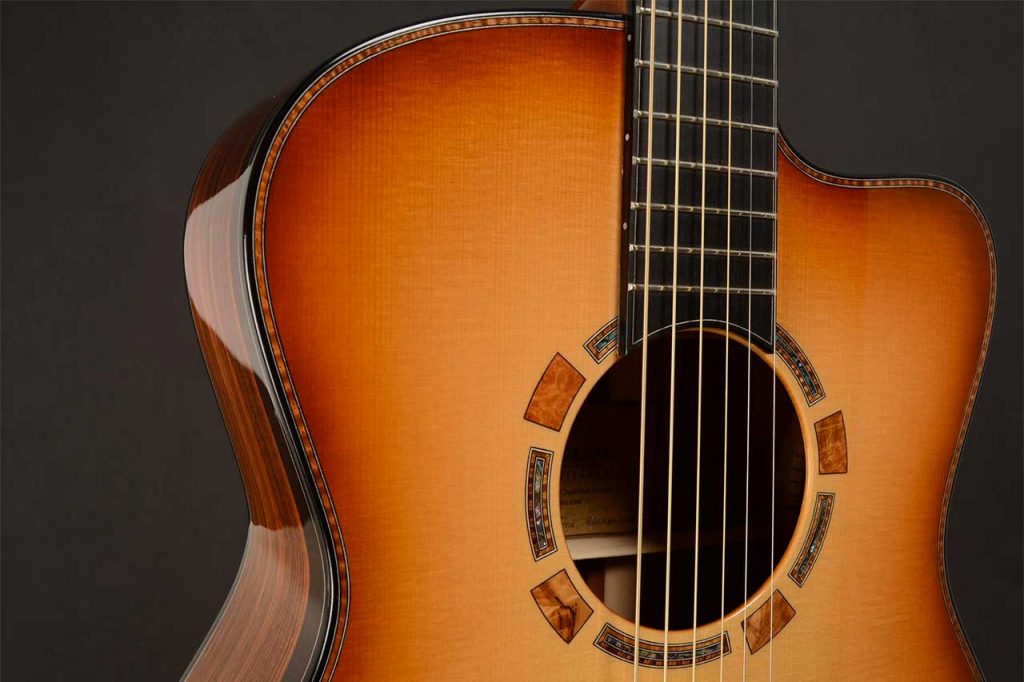
Fejoz Guitars Luthier Interview 1 Background
Vous pouvez également découvrir cette interview en français https://luthiers.com/thomas-fejoz-luthier-interview-1-background/
Fejoz Guitars Luthier – For those who don’t know you yet, can you tell us about your background? Did you go to a luthier school? Did you train with established luthiers? And, if it’s not indiscreet, what did you do before starting this adventure? Were you a musician before becoming a luthier ? Or were you doing something else ? And, by the way, do you still find time to play music with your work as a luthier?
Yes, I went to a lutherie school between 1995 and 1997, I came across this school while doing a skills assessment!
The idea was already there, in a corner of my head, but it seemed unachievable.
Since I was a child, I have never been able to blossom in a normal schooling, always with my head in the clouds and sitting on a chair was unbearable for me.
What saved me was music, it’s my engine! The guitar of course which is my instrument of heart but also the percussions.
When I discovered the existence of this school of lutherie (ITEMM in Le Mans), I said to myself why not! It’s in direct link with music and making something with my hands was a discovery too, I built my first guitar there and it was on its way.
Later, I did a training course with Franck CHEVAL and he supported and motivated me to start my own business.
That’s it! I opened the workshop in 2000 and have been building guitars ever since, the 200 will be released in the next few months…
I play a little bit the guitars I make but not enough for my taste, family life and the workshop take a lot of my time.
I listen to a lot of music, outside but also in the workshop.
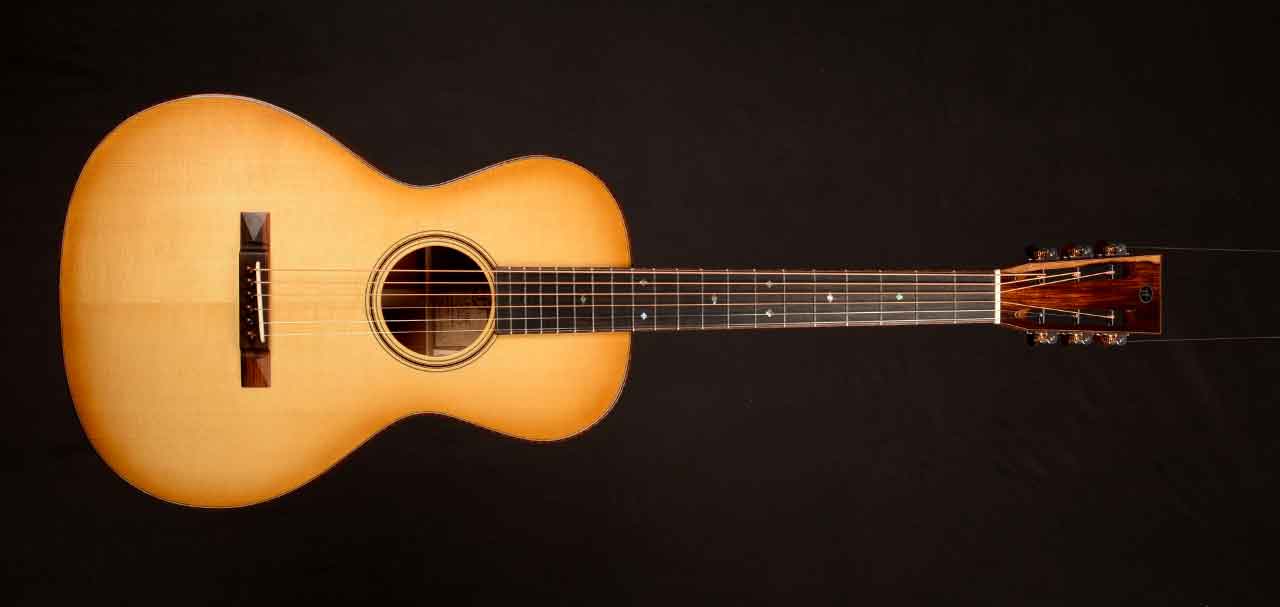
Apart from creating custom instruments, we know that you do all kinds of repairs and maintenance of guitars and basses, can you also take care of other types of plucked and bowed instruments?
There are two of us working in the workshop, Tom POIRIER has been working with me for 5 years now and we do all kinds of repairs on guitars.
Sometimes instruments like the oud or the mandolins / bouzouky come to us for adjustments or small repairs but I prefer to stay in what I master well, we don’t do the instruments of the quartet.
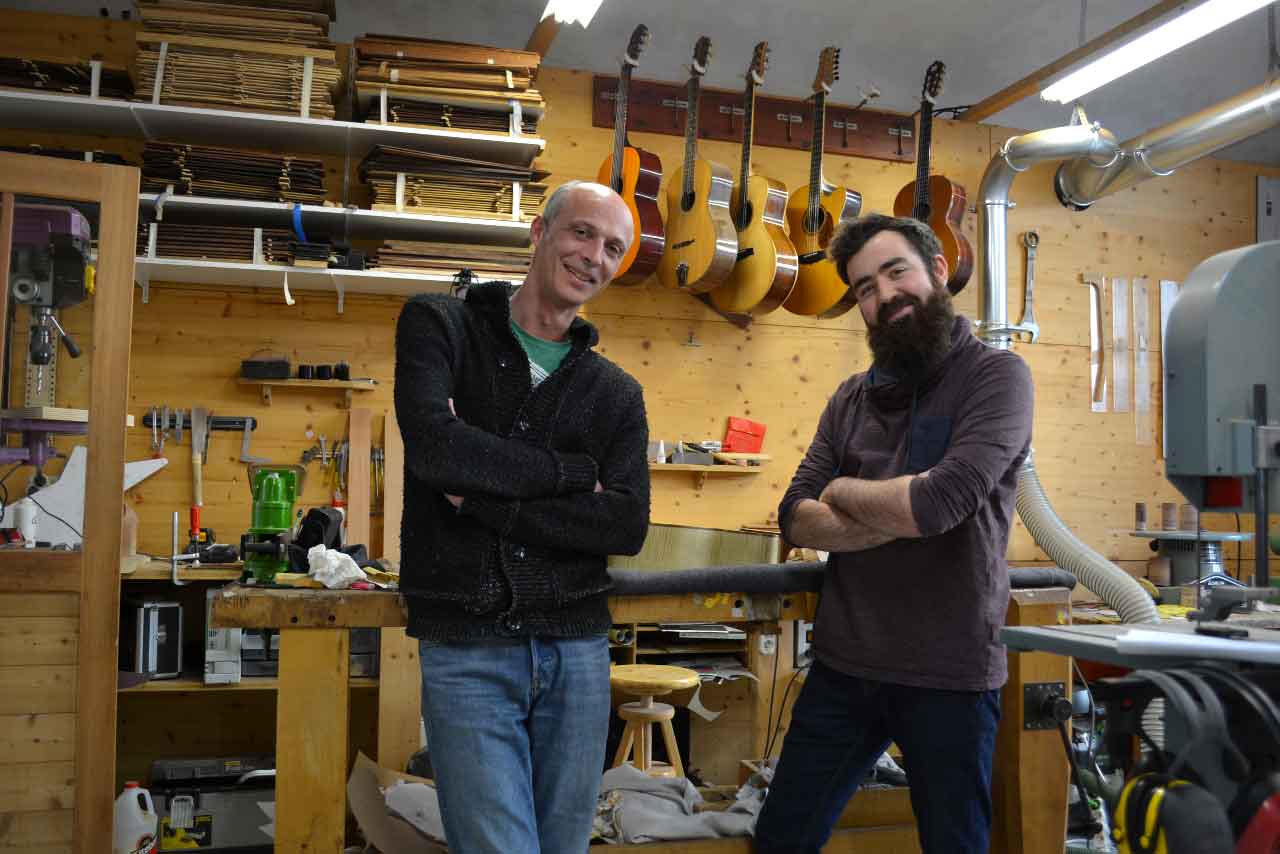
Fejoz Guitars Luthier – Can you tell us about your current flagship models? Do you have a range that you do regularly ? Do you also make unique custom models ? How did you proceed to make them ? What were your choices and your creation process ? What kind of musicians are they for ?
I have developed a wide range of steel string guitars, it is in this specificity that I have the most fun because we can approach a large number of models and different sizes…
Parlor formats: 0/00/000 inspired by Martin guitars but made in my own way of course.
I build a lot of “0” models, this little guitar is a blast! It’s powerful, balanced, very comfortable and very refined, it corresponds to a regular demand at the moment.
I am very fond of the “00” and “000” which are for me very lively guitars for fingerpicking.
I also have a redesigned dreadnought format, two jumbos formats ….
Always with this immense pleasure to vary the sound colors, I realize baritones with fanned fret or not, but also 7 strings, 12 strings on several formats, jumbo, dreadnought, OM ……. I also propose several types of head and bridges according to the model or the desired tuning.
Unlike many luthiers who seek a strong identity by proposing a unique headstock, a unique bridge or a unique shape, I have fun in diversity!
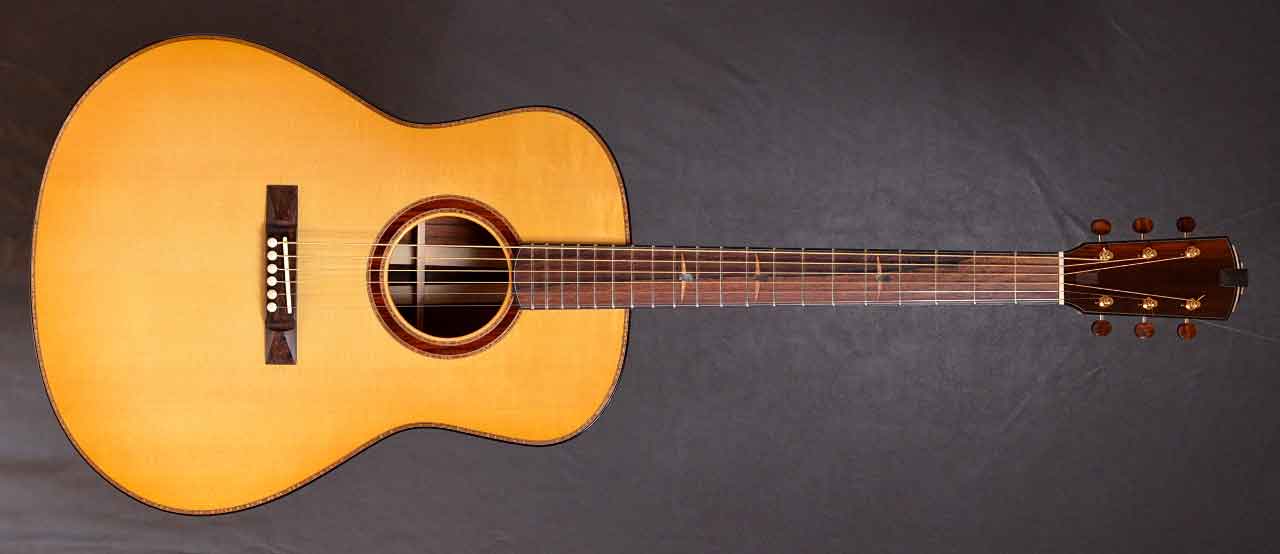
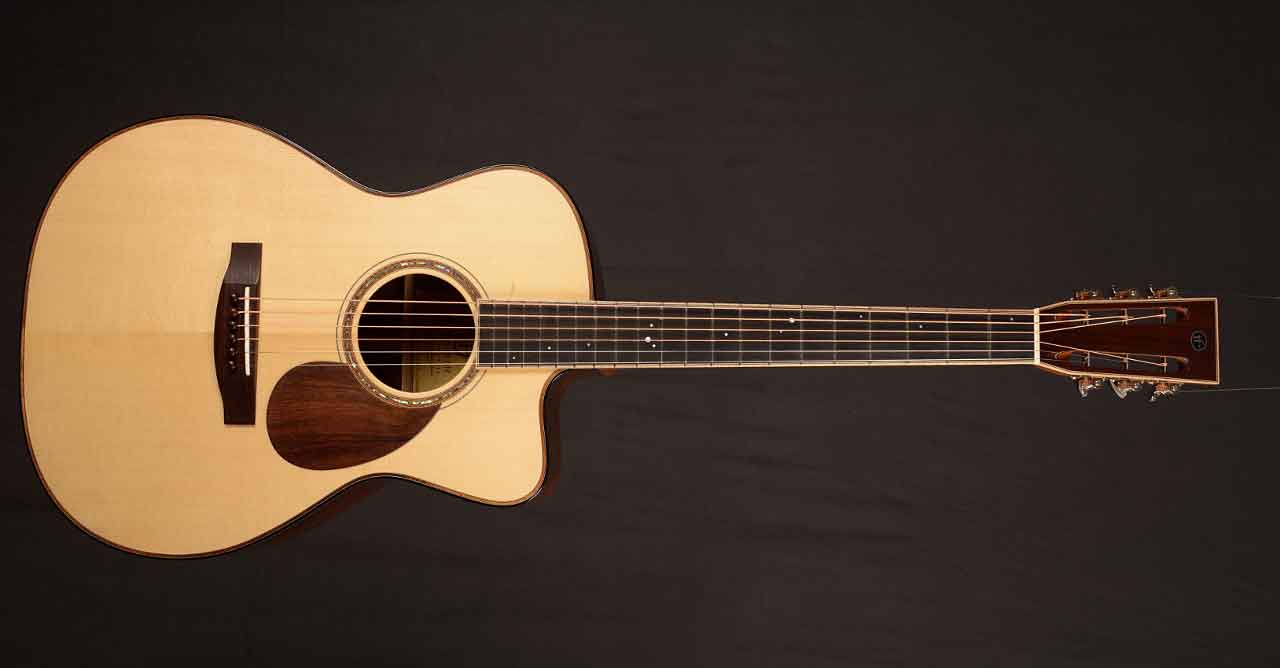
It is a bias which corresponds well to me, the work being essentially manual, I have a great freedom of realization.
My customers are very different, from the professional or amateur musician to the collector… There is no rule, the main thing is to build a unique instrument and really to his idea, and the bulk of my work is to guide my customers to the guitar that will best suit them.
Another part of my work is more specific.
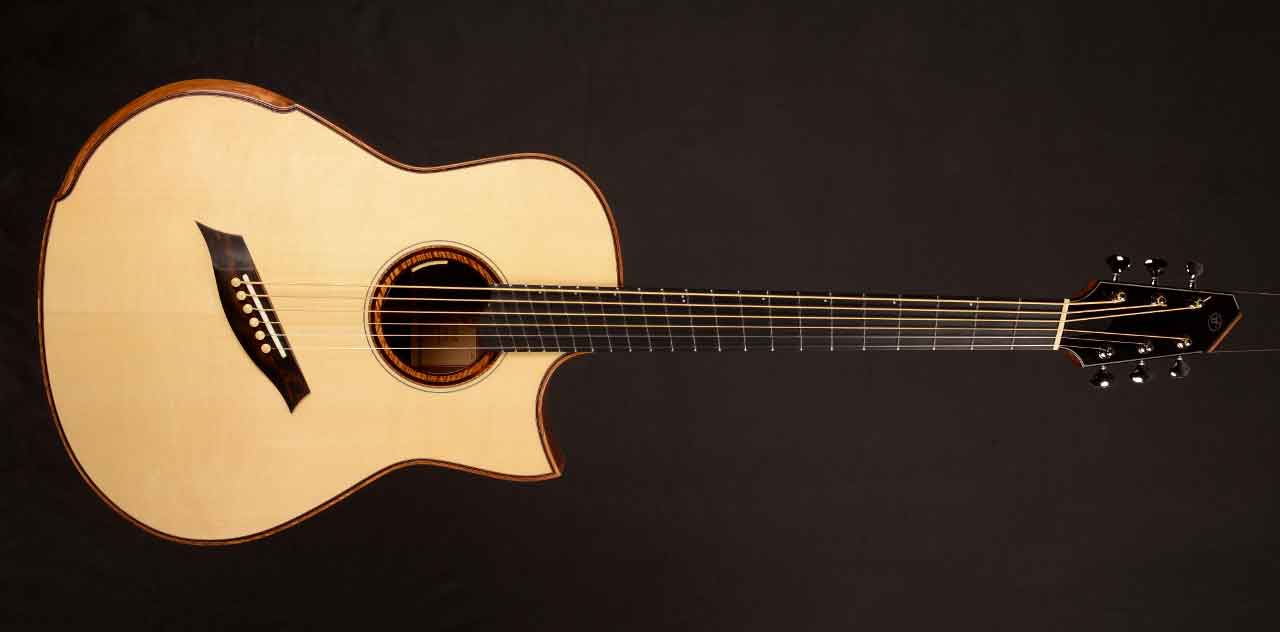
I offer a very different bracing system on my Alizé and small jumbo models, I named this bracing system “soloiste” because the guitar has a wider range, there are some at all levels! It is a very sensitive guitar.
It’s difficult to describe sounds or playing sensations, the ideal is to try but if I had to imagine it, you could say that there is a difference in the response of the instrument, something faster and a wider harmonic spectrum, it’s like comparing a trumpet and a flugelhorn …. it’s close but different at the same time.
I also build archtop guitars, mainly a 16 inch model entirely hand carved.
A 17″ will be released later because I want to redesign it entirely.
I also make some Nylons but more adapted to steel string guitarists, electric guitars too.
On my website, I try to propose very high quality sound recordings to really make you hear the timbre and the tessitura of each instrument, this is of course influenced by the guitarist’s playing but it seems essential to me to propose a faithful listening in the best possible conditions, it is thus necessary to listen with headphones or correct loudspeakers otherwise it is useless.
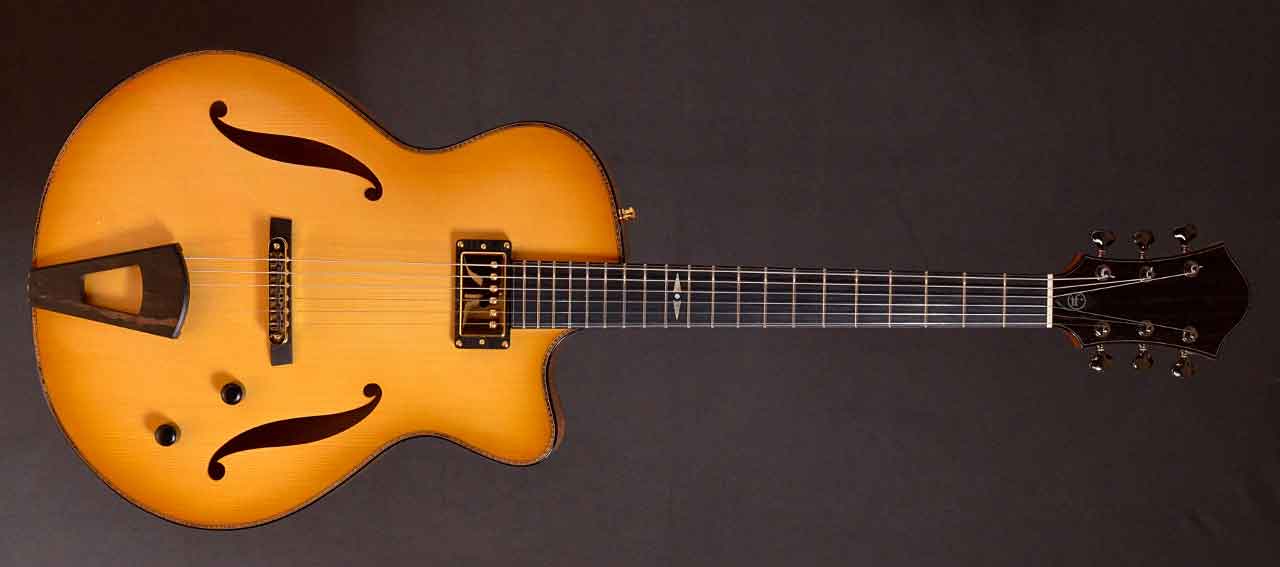
Fejoz Guitars Luthier – Computers have become a part of everyone’s daily life, no matter what profession you practice. Do you use particular tools in the field of lutherie? Can you tell us about them ?
No not really, I can sometimes get help for very specific projects or templates with computer controlled machines, I prefer to have people who have those skills work for me when needed.
I use computers to feed my web site, process the pictures I take of my instruments ….
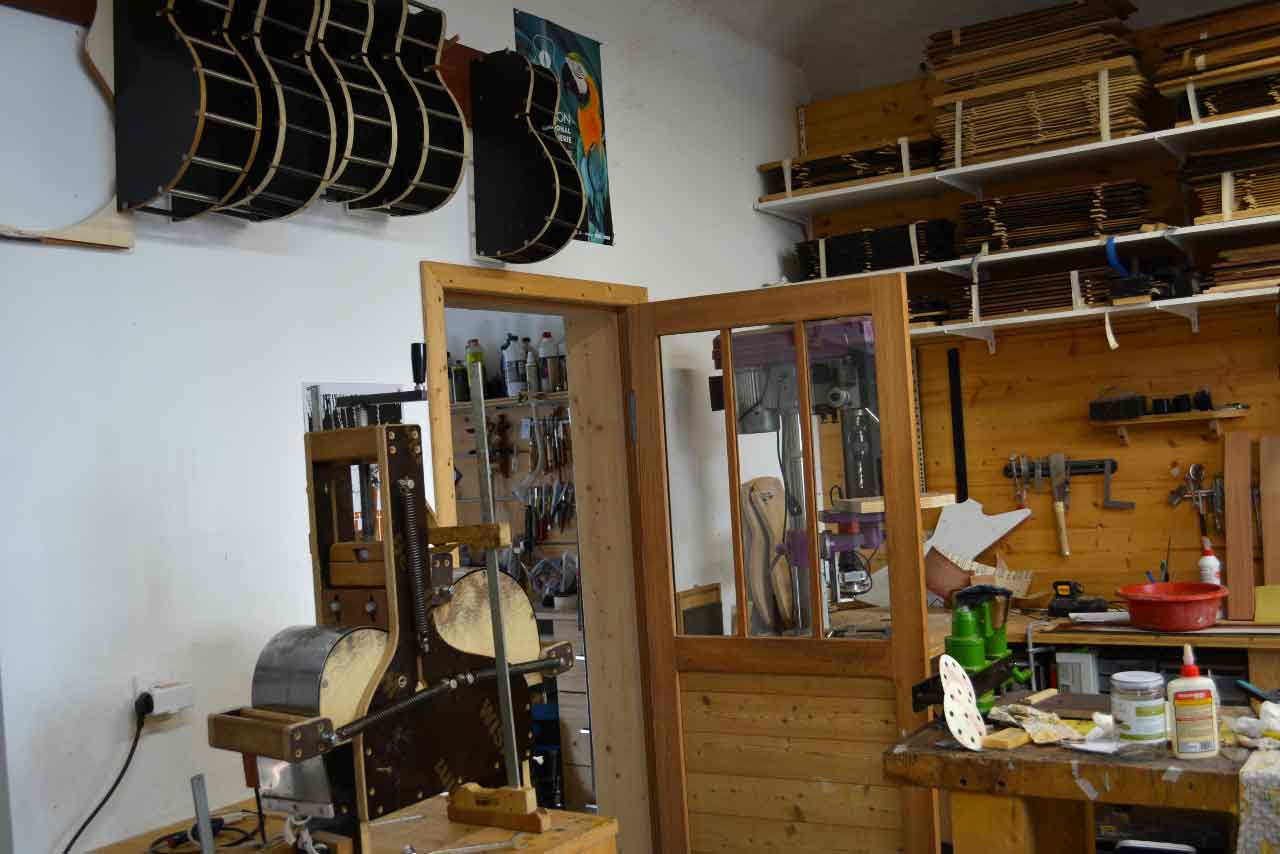
Fejoz Guitars Luthier – Those who know you know that you are a big fan of beautiful woods, how do you help your customers to choose the woods of their future guitar according to the sound they have in mind ? Are you able to find wood easily in your network ? If so, can you name some of your suppliers ?
Each guitarist has a sound “in his ear” and tries to find the sound he already knows.
What comes up quite often is the wish to have a more personal sound, more woody and less metallic, even high-end “industrial” guitars often lack character!
So there is a work to do to explain the impact of the tonewoods on the guitar’s tone…
You have to learn to know them, and learn to put words on sounds, it’s not easy but little by little it’s getting better, it’s really a long learning process and it would take more than a lifetime to go around the question.
The stock of the luthier is made in time, to find the wood is not always easy and it is also necessary to leave time to drying …. I do not believe in the torrefied wood or dried artificially even if it is very useful for ebony keys for example.
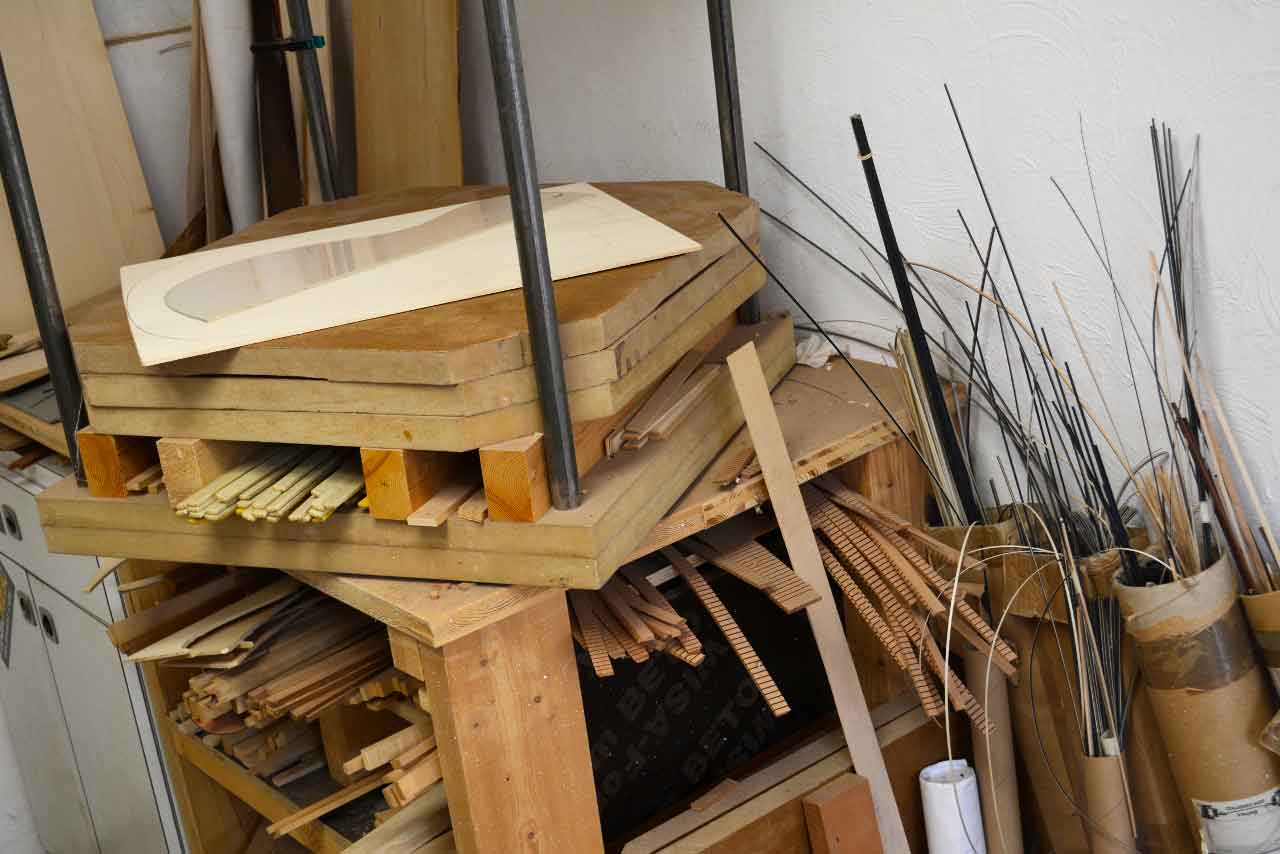
In my opinion, this corresponds to the effects of announcements or we want to make guitarists believe that the guitar can sound like an old one! The good ageing of an instrument is done above all by the vibration.
This profession is timeless and even if it is necessary to live from it, it is opposed for me to a notion of profitability or short-term profit … it is necessary to let time do its work, to let the time to the trees to grow and to stop wanting to make each square meter of the planet profitable.
Nowadays, wood sellers offer very impressive woods visually but also very fragile mechanically and splitting! This is also part of the learning process of this profession.
The guitarist’s playing style will also influence the way the guitar will be made, the string gauge, the profile of the neck, everything is custom made!
It’s haute couture, but that’s how every good instrument should be made.
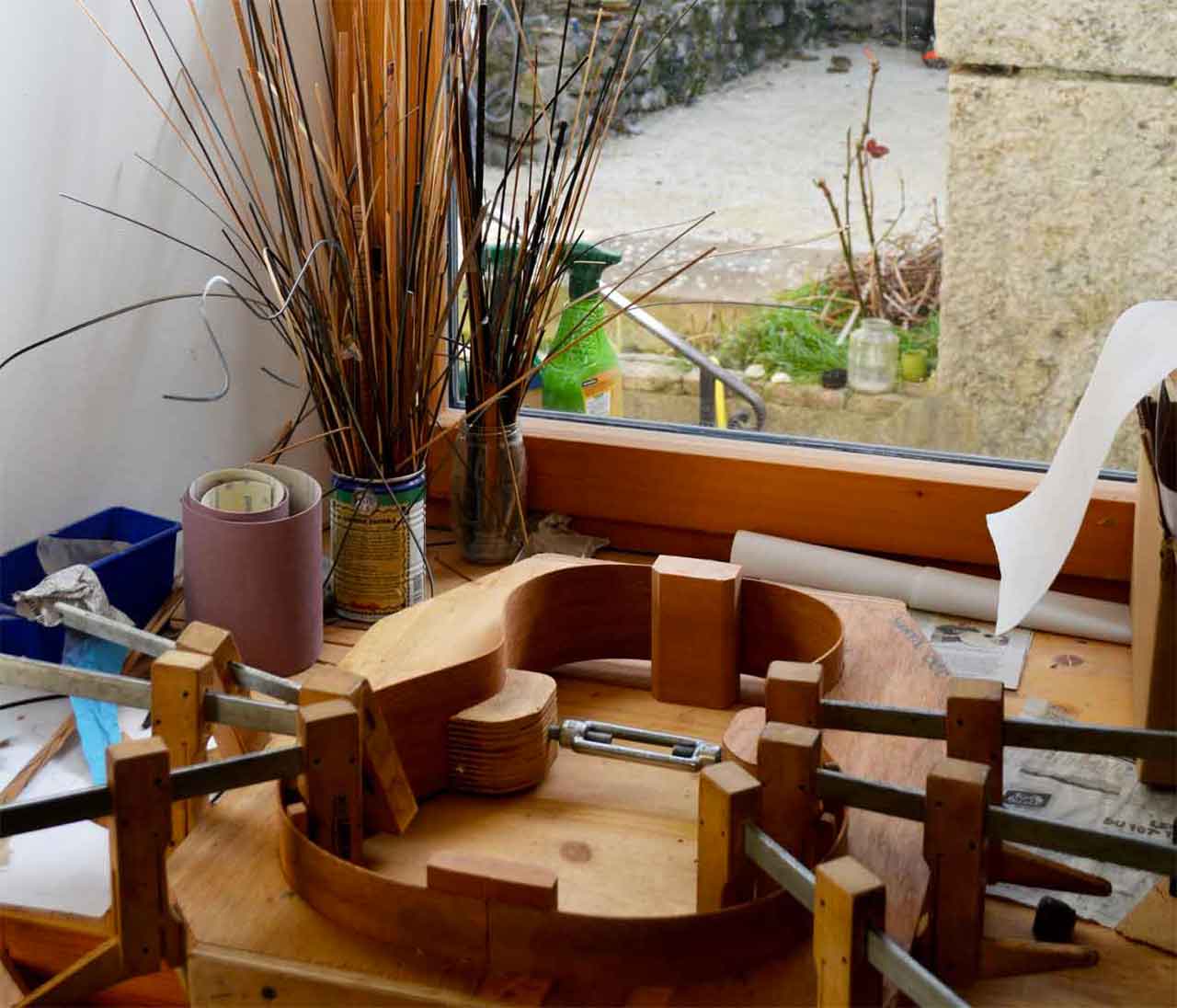
Fejoz Guitars Luthier – There is a huge choice of aftermarket parts. Do you work with regular suppliers or are you always on the lookout for new suppliers who can offer you something new? Do you have any examples to give us?
I work mainly with Fred guitar parts, the relationship is always pleasant, simple and direct, it is my main supplier of fittings.
For the rest I am always looking for new suppliers for wood, strings etc. …..but what matters to me above all is always the quality of materials, the price is not my first criteria.
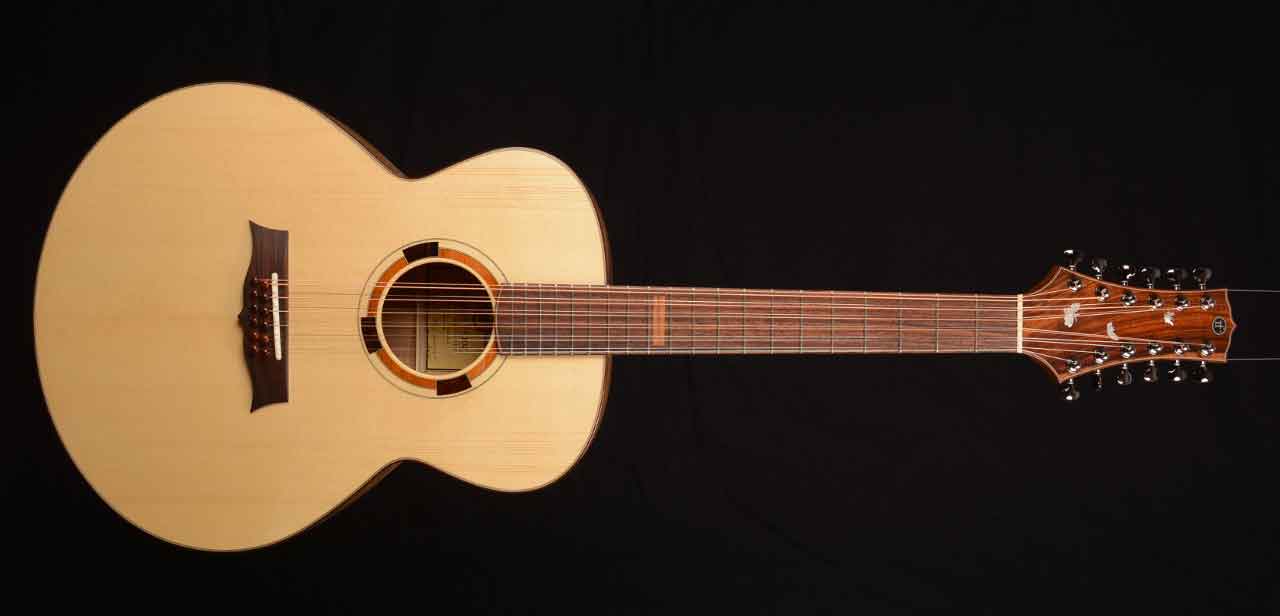
When you can’t find the parts you want from your aftermarket suppliers, do you sometimes create parts yourself or use specialized craftsmen? Can you give us some examples?
Yes, for example I recently had a laser cut clamp for a neck reset on a Gurian guitar, without this tool I would not have been able to do the job properly.
How do you choose the pickups for your electric instruments according to the requests of your customers? Do you have any secrets or habits in terms of wiring? Have you ever had very particular requests, or requests that seemed strange to you from certain clients who had particular needs?
I don’t have many requests for electric guitars because they don’t appear clearly in my catalog.
Either my customers have their pickup models in mind, or I propose Hep cats pickup but it is a new person who took over recently: Julien LANDAT, he made me a paf 57 type pickup which will come on a 16 inches archtop that I am finishing.
I also work with Benedetti pickups, I try to orientate towards a French production if possible.
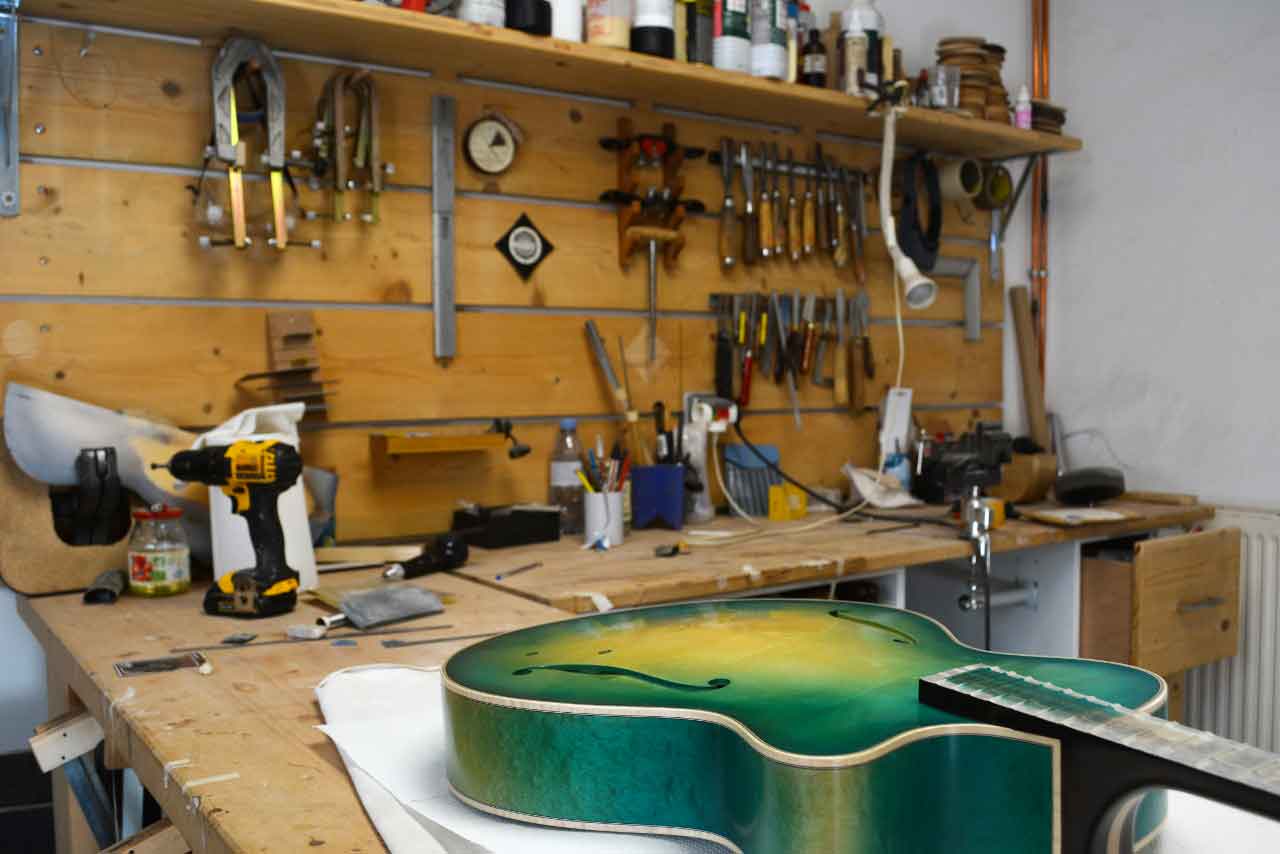
Varnish… Nitrocellulo, P.U (polyurethane) or French polish? What are your choices and why?
My varnish is Nitrocellulose, it is for me the most beautiful varnish and the best adapted to my guitars, it is very fine, very hard and polishes well.
It is also the one I master the best.
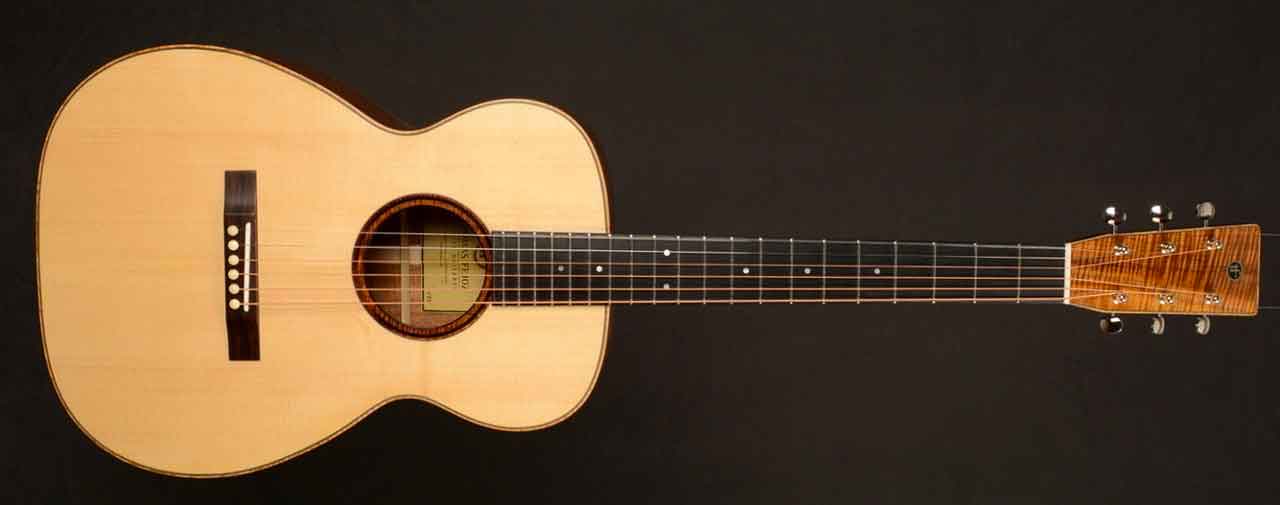
Fejoz Guitars Luthier – How do you help your customers to choose their electro-acoustic sensors?
According to their expectations, simple and efficient, one or two signal sources? The budget?
It’s always a compromise, so I have three references and I play them when possible: lrbaggs/k and K/MISI
Nothing like a mic in front of the guitar or possibly a sign collar dpa4099….
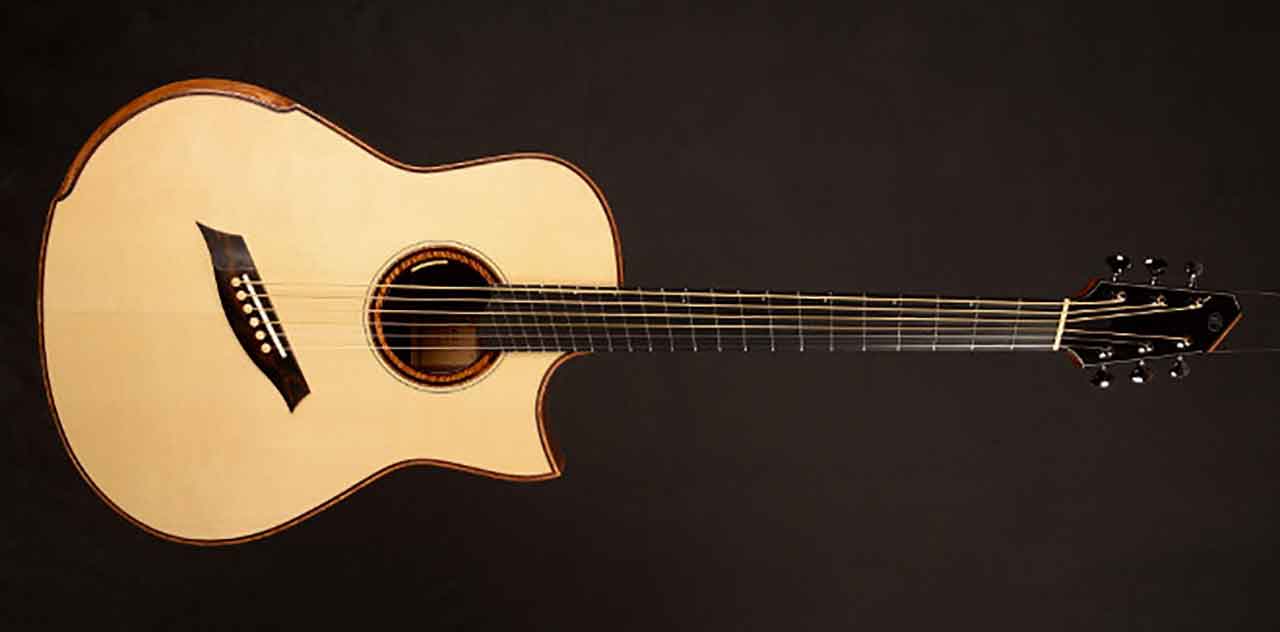
How do you help your customers to choose the fingerboard wood for their instrument in relation to the sound they want to obtain? Can you tell us about the impact of this choice in relation to the other woods used in the construction of an instrument?
For me it is essentially ebony or rosewood, maple more rarely on acoustic but I can propose it on an electric instrument…
I’m mostly talking about the density of the wood and how it will age.
The touch is very personal! and the difference of sound at the attack of the note can be more clear with a denser wood but I think that is very subjective.

Are you also interested in building amps and effects? And, if not, are you going to go in this direction like many other luthiers?
Not for now!
Do you have any advice to give to future young luthiers? Can you give them advice on training? Do you know of any specialized schools?
You have to hang on!!!
It’s hard and it’s long, especially in manufacturing ….. there are several schools in France and abroad.
The ITEMM, in France, is a school that provides a serious and good quality training with good teachers!
The most difficult thing is also to find an apprenticeship master when the training is done in alternation.
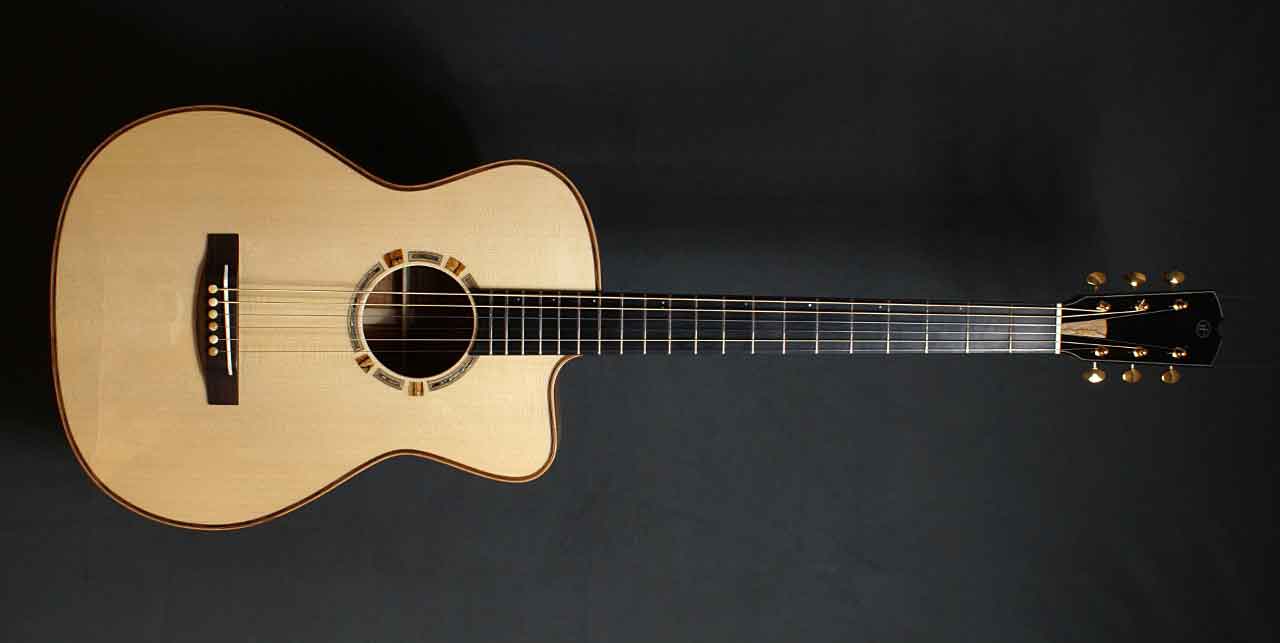
Fejoz Guitars Luthier – The profession of luthier is a profession that requires an important material investment to start its activity. What would you advise a young luthier to buy to start ? The minimum required ? And, the maximum to be in a comfort of work ?
This is a question that can be very broad! It all depends on what you want to do: manufacture / repair ….. it does not require the same tools.
Moreover, one can make lutherie with very different tools depending on whether one likes machines or a more manual work, not to mention the fact that one has to make some machines for very specific operations.
For me, the machines are an essential help to go a little faster and bring more comfort but it must remain an essentially manual work, it is necessary to adapt permanently to the woods which one uses and it is completely incoherent to use a too mechanized and uniform process…
No two pieces of wood are the same and this is true, of course, especially for acoustics.
For the rest, the industry is there and I don’t see the point of trying a too mechanized production except of course to reduce the construction costs and the working time but the result is also consequent.
I don’t really answer your question but to enumerate a list of tools is for me rather boring I admit it!
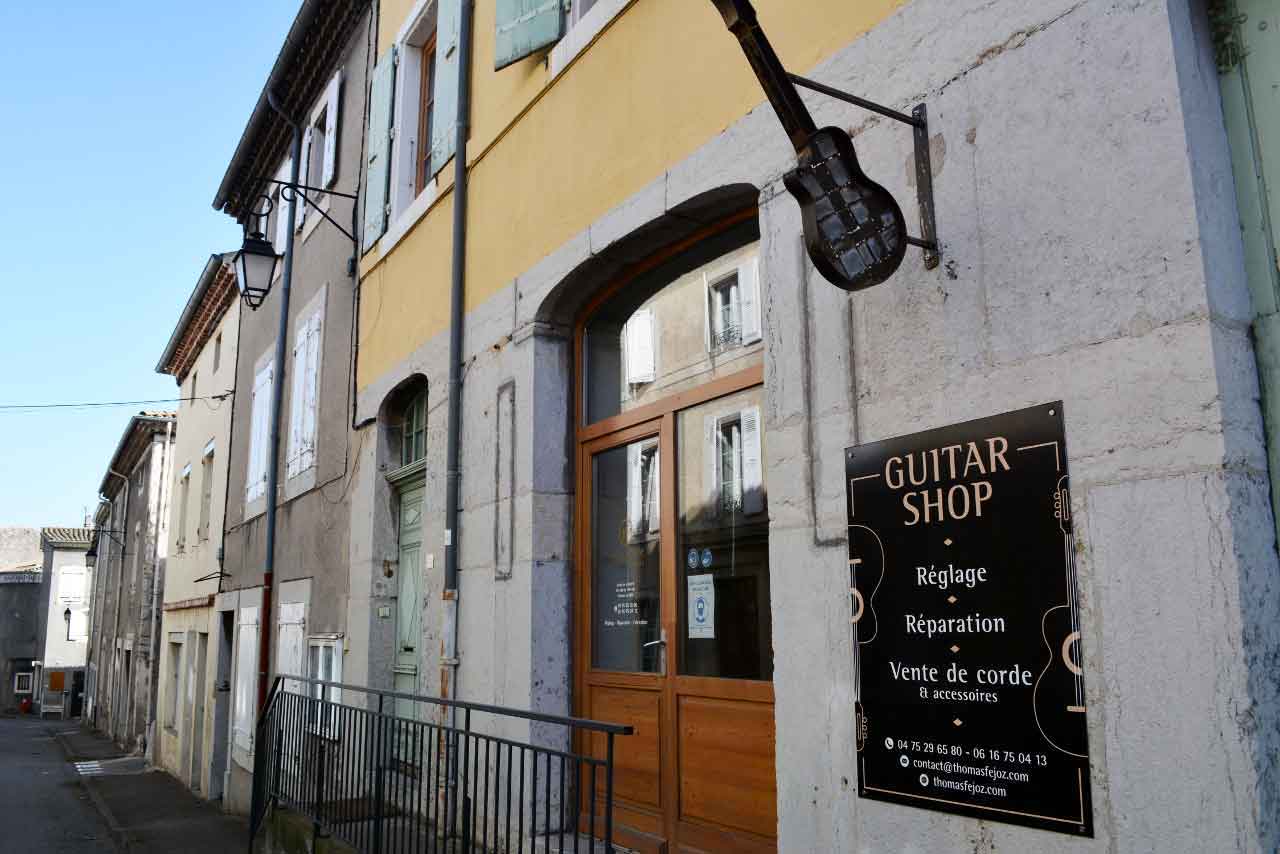
You can contact Thomas of Fejoz Guitars
using the contact form on his personal page on Luthiers.com here :
https://luthiers.com/listing/thomas-fejoz-guitare/
We also invite you to follow him on his various social networks:
- Facebook: https://www.facebook.com/Thomas-FEJOZ-guitare-1713155962076582
- Instagram: https://www.instagram.com/thomasfejoz/
- Website: http://www.thomasfejoz.com/fr/
Thomas Féjoz Luthier Interview 1 Background
Discover François Sciortino Monaco playing A waltz on a Thomas Féjoz OM guitar
Thomas Féjoz Luthier Interview 1 Background
Discover Thomas Djalloul playing “Blue Liquid” on a Thomas Féjoz Baritone guitar
Thomas Féjoz Luthier Interview 1 Background
In the coming weeks, as for others luthiers for plucked string instruments, luthiers for bowed string instruments, amps & effects makers, wood & supplies dealers, lutherie events, jobs, schools & teachers subscribers on our site, you will be able to follow our series of mini-interviews dedicated to the fascinating world of luthiers.
See you soon…
#luthiers
Subscribe to the newsletter!
Subscribe to our newsletter to follow all our news and those of our luthiers.
If you are passionate about the world of luthiers, join us!